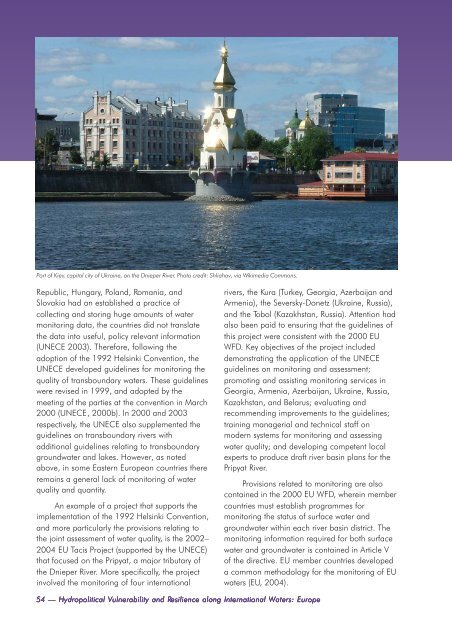Europe - UNEP
Europe - UNEP
Europe - UNEP
Create successful ePaper yourself
Turn your PDF publications into a flip-book with our unique Google optimized e-Paper software.
Port of Kiev, capital city of Ukraine, on the Dnieper River. Photo credit: Shliahov, via Wikimedia Commons.<br />
Republic, Hungary, Poland, Romania, and<br />
Slovakia had an established a practice of<br />
collecting and storing huge amounts of water<br />
monitoring data, the countries did not translate<br />
the data into useful, policy relevant information<br />
(UNECE 2003). Therefore, following the<br />
adoption of the 1992 Helsinki Convention, the<br />
UNECE developed guidelines for monitoring the<br />
quality of transboundary waters. These guidelines<br />
were revised in 1999, and adopted by the<br />
meeting of the parties at the convention in March<br />
2000 (UNECE, 2000b). In 2000 and 2003<br />
respectively, the UNECE also supplemented the<br />
guidelines on transboundary rivers with<br />
additional guidelines relating to transboundary<br />
groundwater and lakes. However, as noted<br />
above, in some Eastern <strong>Europe</strong>an countries there<br />
remains a general lack of monitoring of water<br />
quality and quantity.<br />
An example of a project that supports the<br />
implementation of the 1992 Helsinki Convention,<br />
and more particularly the provisions relating to<br />
the joint assessment of water quality, is the 2002–<br />
2004 EU Tacis Project (supported by the UNECE)<br />
that focused on the Pripyat, a major tributary of<br />
the Dnieper River. More specifically, the project<br />
involved the monitoring of four international<br />
rivers, the Kura (Turkey, Georgia, Azerbaijan and<br />
Armenia), the Seversky-Donetz (Ukraine, Russia),<br />
and the Tobol (Kazakhstan, Russia). Attention had<br />
also been paid to ensuring that the guidelines of<br />
this project were consistent with the 2000 EU<br />
WFD. Key objectives of the project included<br />
demonstrating the application of the UNECE<br />
guidelines on monitoring and assessment;<br />
promoting and assisting monitoring services in<br />
Georgia, Armenia, Azerbaijan, Ukraine, Russia,<br />
Kazakhstan, and Belarus; evaluating and<br />
recommending improvements to the guidelines;<br />
training managerial and technical staff on<br />
modern systems for monitoring and assessing<br />
water quality; and developing competent local<br />
experts to produce draft river basin plans for the<br />
Pripyat River.<br />
Provisions related to monitoring are also<br />
contained in the 2000 EU WFD, wherein member<br />
countries must establish programmes for<br />
monitoring the status of surface water and<br />
groundwater within each river basin district. The<br />
monitoring information required for both surface<br />
water and groundwater is contained in Article V<br />
of the directive. EU member countries developed<br />
a common methodology for the monitoring of EU<br />
waters (EU, 2004).<br />
54 — Hydropolitical Vulnerability and Resilience along International Waters: <strong>Europe</strong>
















